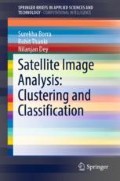Abstract
With the recent developments in sensors, communication and satellite technology, data storage, processing, and networking capabilities, satellite image acquisition and mining are on the rise. Satellite images play a vital role in providing geographical information. Satellite image classification identifies the land cover/land use and labels each class entity by applying decision rules on numerical values of pixels, which represents the average spectral reflectance. The design of highly accurate decision support systems, assists and eases the data analysts. Integrating the Machine Learning (ML) technology with the human visual psychometric helps meet the demands of the geologists to improve the efficiency and quality of classification in real time, reduces human errors, and allows fast and rigorous analysis of land use and land cover information. This chapter presents an overview of satellite imaging system, imaging sensors, resolutions, distortions, image interpreters, automatic classifiers, and their performance assessment methods.
Access this chapter
Tax calculation will be finalised at checkout
Purchases are for personal use only
References
Kumar, D. N. (2014). Remote sensing. Retrieved July, 2018, from https://nptel.ac.in/courses/105108077/.
Observation by sensor and type of sensor. Retrieved July, 2018, from http://www.eorc.jaxa.jp/en/hatoyama/experience/rm_kiso/mecha_howto_e.html.
Dey, N., Bhatt, C., & Ashour, A. S. (2018). Big data for remote sensing: Visualization, analysis and interpretation. Cham: Springer.
Gibson, P. J. (2000). Introductory remote sensing—Principles and concepts. London: Routledge.
Philpot, W. (2001). Geometric correction, chapter 4. In Digital image processing (p. 85). Cornell University.
Vohland, M., Stoffels, J., Hau, C., & Schuler, G. (2007). Remote sensing techniques for forest parameter assessment: Multispectral classification and linear spectral mixture analysis. Silva Fennica, 41(3), 441.
Stehman, S. V., & Czaplewski, R. L. (1998). Design and analysis for thematic map accuracy assessment: Fundamental principles. Remote Sensing of Environment, 64(3), 331–344.
Foody, G. M. (1992). On the compensation for chance agreement in image classification accuracy assessment. Photogrammetric Engineering & Remote Sensing, 58, 1459–1460.
Ma, Z., & Redmond, R. L. (1995). Tau coefficients for accuracy assessment of classification of remote sensing data. Photogrammetric Engineering and Remote Sensing, 61(4), 435–439.
Klecka, W. R., & Klecka, W. R. (1980). Discriminant analysis (Vol. 19). Newbury Park: Sage.
Congalton, R. G. (1991). A review of assessing the accuracy of classifications of remotely sensed data. Remote Sensing of Environment, 37(1), 35–46.
Hardin, P. J., & Shumway, J. M. (1997). Statistical significance and normalized confusion matrices. Photogrammetric Engineering and Remote Sensing, 63(6), 735–739.
Lu, D., & Weng, Q. (2007). A survey of image classification methods and techniques for improving classification performance. International Journal of Remote Sensing, 28(5), 823–870.
Maselli, F., Conese, C., & Petkov, L. (1994). Use of probability entropy for the estimation and graphical representation of the accuracy of maximum likelihood classifications. ISPRS Journal of Photogrammetry and Remote Sensing, 49(2), 13–20.
Finn, J. T. (1993). Use of the average mutual information index in evaluating classification error and consistency. International Journal of Geographical Information Science, 7(4), 349–366.
Foody, G. M. (1996). Approaches for the production and evaluation of fuzzy land cover classifications from remotely-sensed data. International Journal of Remote Sensing, 17(7), 1317–1340.
Ricotta, C. (2004). Evaluating the classification accuracy of fuzzy thematic maps with a simple parametric measure. International Journal of Remote Sensing, 25(11), 2169–2176.
Ricotta, C., & Avena, G. C. (2002). Evaluating the degree of fuzziness of thematic maps with a generalized entropy function: A methodological outlook. International Journal of Remote Sensing, 23(20), 4519–4523.
Renyi, A. (1970). Probability theory. Amsterdam: North Holland Publishing Company.
Morisita, M. (1959). Measuring of the dispersion of individuals and analysis of the distributional patterns. Memoirs of the Faculty of Science, Kyushu University, Series E, 2(21), 5–23.
Hayes, J. J., & Castillo, O. (2017). A new approach for interpreting the Morisita index of aggregation through quadrat size. ISPRS International Journal of Geo-Information, 6(10), 296, 1–15.
Author information
Authors and Affiliations
Rights and permissions
Copyright information
© 2019 The Author(s), under exclusive licence to Springer Nature Singapore Pte Ltd.
About this chapter
Cite this chapter
Borra, S., Thanki, R., Dey, N. (2019). Introduction. In: Satellite Image Analysis: Clustering and Classification. SpringerBriefs in Applied Sciences and Technology(). Springer, Singapore. https://doi.org/10.1007/978-981-13-6424-2_1
Download citation
DOI: https://doi.org/10.1007/978-981-13-6424-2_1
Published:
Publisher Name: Springer, Singapore
Print ISBN: 978-981-13-6423-5
Online ISBN: 978-981-13-6424-2
eBook Packages: EngineeringEngineering (R0)

